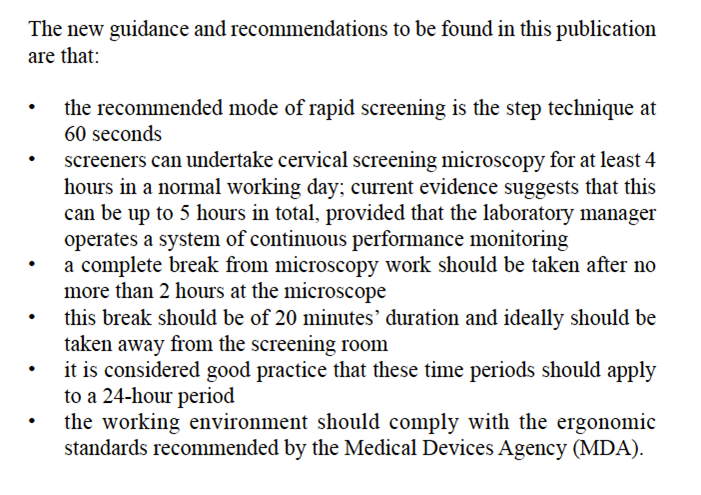A certified regulatory body that is qualified to audit the laboratory can perform various forms of EQA.
- Technical EQA scheme to examine the quality of staining.
- Proficiency testing scheme to examine the quality of screener/consultant reporting.
- Accreditation and certification of cytotechnologists and cytopathologists.
- Appraisal of management, laboratory organisation and performance.
- Achievable performance standards for comparison between laboratories and regions in the form of sensitivity of primary screening, reporting rates for abnormalities, inadequate rates, positive predictive value and referral value may be regarded as a form of external quality assurance (Wiener et al. 2007; HSCIC 2014).
Technical EQA is a scheme in place where the laboratory has a nominated month to send a set of slides for staining evaluation. Screeners from other laboratories perform the evaluation blindly and a score is given. Laboratories that fail this evaluation are given a certain amount of time to rectify the issue and will be re-evaluated accordingly.
Proficiency testing schemes use Papanicolaou-stained cervical cytology slides selected as good examples by a panel of pathologists and cytotechnologists. The cases are delivered to each cytology laboratory participating in the scheme where all members of staff who undertake cervical screening are given a set of 10 slides to screen and report. The answers are either sent to the organisers or entered into an online reporting facility where they are logged and marked. The scheme is in place to detect unacceptable levels of false negatives and false positive. Confidentiality is an essential component of the scheme.
Accreditation is a process by which a committee of experts, appointed by an independent agency, evaluates and certifies whether an institute or laboratory satisfies predetermined standards, which have been previously agreed by the group. Being an accredited organisation provides reassurance to laboratory users/customers that there are robust, quality assurance systems in place that assure the quality of reporting.
- Clinical Laboratory Accreditation (UK) is now part of the UK Accreditation Service (UKAS), whose website (http://www.ukas.com/services/CPA/Clinical_Pathology_Accreditation_CPA.asp) links to pan-European ISO 9000 accreditation schemes.
- Accreditation in the US is available through the American College of Pathologists (http://www.cap.org/apps//cap.portal?_nfpb=true&_pageLabel=accreditationaand is regulated by the Centers for Disease Control and Prevention (http://wwwn.cdc.gov/clia/).
Certification of the skill and experience of a cytotechnologist has an important impact on the quality of the reports issued by the laboratory. The European Federation of Cytology Societies (EFCS) QUATE Aptitude test for cervical cytology is an international test, which is designed to provide an objective assessment of a cytotechnologist’s competence to screen cervical smears. It can be taken by cytotechnologists who have passed their national or regional examination (if there is one) or who have had a minimum of two years experience (5000 smears per annum) of cervical screening.
Laboratory organisation
The European guidelines provide recommendations for training, buildings, rooms and furniture, laboratory and office equipment, handling and anaylsis of samples, workload requirements and archiving – in addition to recommendations for internal and external quality assurance of screening and reporting (Wiener et al. 2007).
The NHSCSP has developed comprehensive guidelines on laboratory practice with recommendations (Figure 11.2) specifically designed to avoid ‘sources of error’ described above (NHSCSP 2003a).
While compliance with these recommendations will vary between countries and regions the principles of these documents reflect the importance of work practice in determining good laboratory performance.

Ergonomic standards recommended by the Medical Devices Agency (MDA) (NHSCSP 2003b) provides MDA recommendations for ergonomic microscopes, suitable chairs for microscopy and use of computers, and space for personnel, furniture and equipment.
Again, compliance with these recommendations will vary in different regions and countries but the principles are consistent with avoiding ‘sources of error’ described above,


